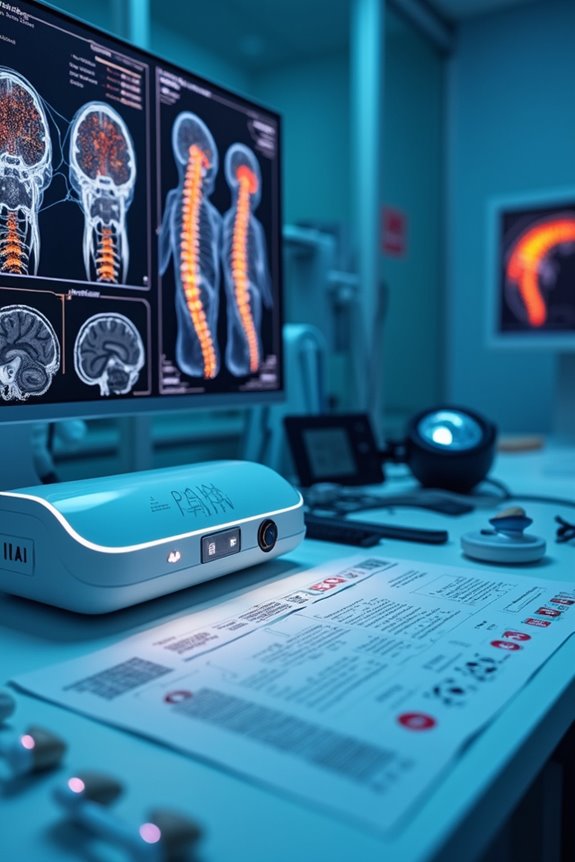International standards for pain management are guided by several key organizations. The World Health Organization (WHO) emphasizes integrated approaches, including palliative care. The Centers for Disease Control and Prevention (CDC) recommend cautious opioid prescribing, prioritizing nonopioid therapies. The American Society of Anesthesiologists (ASA) provides detailed practice guidelines focusing on individualized treatment plans. Collaborative efforts among specialists and agencies aim for cohesive policies to improve outcomes. For further insights into specific guidelines and strategies, additional exploration is warranted.
Key Takeaways
- International pain management guidelines are developed by organizations like IASP, WHO, AAPM, and EUSEM, providing evidence-based recommendations for various pain conditions.
- WHO emphasizes integrated approaches for chronic pain management and advocates for palliative care across all age groups.
- CDC recommends nonopioid therapies as first-line treatment and limits initial opioid prescriptions to 3-7 days while prioritizing patient safety.
- Multispecialty task forces aim to address gaps in pain management practices and promote multidisciplinary treatment strategies for acute and chronic pain.
- ASA guidelines focus on individualized treatment plans, thorough pain assessments, and continuous monitoring to optimize patient outcomes.
Overview of International Pain Management Guidelines
An overview of international pain management guidelines reveals an extensive framework aimed at improving pain treatment globally. These guidelines are essential resources for clinicians, providing evidence-based recommendations that span various pain types and conditions.
Key components include:
- International Association for the Study of Pain (IASP): Focuses on systematic clinical practices and addresses torture-related pain scenarios.
- World Health Organization (WHO): Updated chronic pain management guidelines emphasize integrated approaches for all age groups, including children.
- American Academy of Pain Medicine (AAPM): Develops tailored clinical practice guidelines for both chronic and acute pain contexts, addressing public health crises.
- European Society for Emergency Medicine (EUSEM): Offers thorough acute pain management guidelines adaptable to national contexts.
Collectively, these international guidelines promote standardized, accessible pain treatment worldwide.
Role of the World Health Organization in Pain Care

The World Health Organization (WHO) plays a pivotal role in advancing pain care on a global scale, building on the extensive framework established by international guidelines.
- WHO initiatives focus on updating pain management guidelines, addressing opioid misuse while improving access to pain relief in low- and middle-income countries.
- The Organization emphasizes palliative care, incorporating it into Essential Medicines Lists for all age groups, as mandated by the 2014 World Health Assembly resolution.
- WHO advocates for effective pain management strategies, particularly for chronic conditions like low back pain, which affects approximately 619 million people worldwide.
- By improving access to controlled medicines and promoting regulatory reforms, WHO aims to reduce disparities in pain medication availability, fostering equitable health outcomes globally.
CDC Recommendations on Opioid Prescribing

When considering opioid prescribing for pain management, healthcare providers must carefully evaluate the balance between potential benefits and risks to the patient. The CDC recommends that opioids be initiated only when their benefits for pain relief and functional improvement outweigh associated risks.
- Prioritize nonopioid therapies for acute, subacute, and chronic pain.
- Use shared decision-making to discuss opioid initiation and potential risks with patients.
- Start with immediate-release opioids at the lowest effective dosage, making careful dosage adjustments as necessary.
- Limit initial prescriptions to the shortest duration feasible, typically 3-7 days.
- Regularly reassess pain control and function, adjusting treatment based on individual patient responses.
These guidelines aim to enhance safety and optimize pain management outcomes.
Multispecialty and Interagency Task Force Contributions

Multispecialty and interagency task force contributions play a pivotal role in standardizing pain management practices across healthcare systems.
- These collaborations aim to identify gaps and inconsistencies in pain management, fostering a patient-centered approach.
- Multispecialty collaboration brings together experts from various fields, enhancing treatment strategies for both acute and chronic pain.
- Interagency coordination among federal and state agencies promotes coherent policies that integrate public health and clinical perspectives.
- Task forces analyze opioid prescribing data and treatment efficacy, ensuring guidelines reflect evolving evidence.
- Recommendations emphasize multidisciplinary treatment modalities to improve patient outcomes, balancing effective pain relief with risk mitigation.
Through these contributions, healthcare professionals can develop thorough and relevant pain management strategies, ultimately enhancing patient care.
American Society of Anesthesiologists Practice Guidelines

American Society of Anesthesiologists (ASA) Practice Guidelines for pain management provide a structured framework to assist clinicians in making informed decisions regarding patient care.
Key Components of ASA Guidelines:
- Pain Assessment: Thorough evaluations including history, physical exams, and diagnostic testing.
- Treatment Strategies: Individualized plans that merge pharmacologic and nonpharmacologic approaches, emphasizing multidisciplinary methods.
- Patient Education: Encouragement of informed consent and realistic treatment goals, stressing the importance of communication.
- Monitoring: Continuous assessment of treatment outcomes, adapting plans to optimize long-term pain control.
These guidelines, advisory rather than mandatory, undergo periodic revisions to incorporate advancements in medical knowledge and technology, ensuring that both chronic and acute pain management is addressed with personalized care approaches.
Pain Assessment and Management Standards by The Joint Commission
The Joint Commission established extensive pain assessment and management standards, effective January 1, 2018, to enhance the quality and safety of pain management across accredited hospitals.
Key components include:
- Application to all Joint Commission-accredited hospitals and, expanded in 2019, to ambulatory care and critical access hospitals.
- Integration into accreditation manual chapters: Leadership, Medical Staff, Provision of Care, and Performance Improvement.
- Requirement for standardized, thorough pain assessments that evaluate intensity, quality, and functional impact.
- Documentation and regular reassessment of pain management strategies.
- Emphasis on multimodal pain management to minimize opioid reliance.
Leadership must guarantee compliance, while continuous performance improvement activities focus on pain assessment and management outcomes, fostering collaboration among interdisciplinary teams.
Importance of Multidisciplinary Approaches in Pain Management
Effective pain management necessitates an extensive, multidisciplinary approach that integrates various specialties to address the multifaceted nature of pain. This collaborative care model includes:
- Specialist Inclusion: Physicians, psychologists, physical therapists, and occupational therapists contribute their expertise.
- Comprehensive Assessment: It examines biomedical, psychological, and social aspects simultaneously, optimizing individualized care plans.
- Continuous Monitoring: Team-based collaboration allows for regular adjustments to therapy based on patient feedback.
Research indicates that integrating behavioral health interventions enhances patient outcomes, particularly for those with coexisting mental health conditions. Additionally, physical and restorative therapies improve functional abilities and quality of life. Ultimately, a multidisciplinary framework fosters holistic care, increasing engagement and satisfaction for patients maneuvering through complex pain experiences.
Frequently Asked Questions
How Can Patients Advocate for Better Pain Management in Healthcare Settings?
In a world where silence often echoes louder than pain, patients can advocate for better pain management through empowerment and engagement, influencing healthcare policies by voicing their experiences and demanding personalized, compassionate care tailored to their needs.
What Role Do Caregivers Play in Managing Chronic Pain in Children?
Caregivers play an essential role in managing chronic pain in children through caregiver support and pain assessment. They observe symptoms, advocate for tailored interventions, and provide emotional reassurance, fostering a nurturing environment that promotes healing and comfort.
Are There Specific Pain Management Guidelines for Elderly Patients?
Elderly pain often feels like a relentless storm, yet specific management guidelines exist. These guidelines emphasize thorough strategies, blending pharmacological and non-pharmacological approaches to guarantee a compassionate, effective response to the unique challenges faced by older adults.
How Do Cultural Factors Influence Pain Management Practices Internationally?
Cultural factors substantially influence pain management practices internationally, as varying cultural perceptions shape pain experiences and expressions. Traditional remedies often coexist with biomedical treatments, affecting patients’ willingness to engage with conventional healthcare approaches and shaping their overall treatment outcomes.
What Training Do Healthcare Professionals Receive on Pain Management Standards?
In a world where pain is often an invisible foe, healthcare professionals undergo rigorous training encompassing pain assessment and thorough treatment protocols, fostering a unified approach that enhances collective understanding and efficacy in managing patient discomfort.





